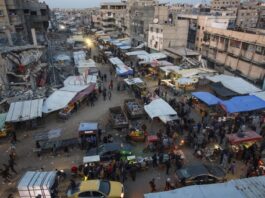BRATISLAVA, Slovakia (AP) — A train traveling from the Czech capital of Prague to the Hungarian capital of Budapest collided with a local bus in southern Slovakia on Thursday, leaving at least seven people dead and five injured, officials said.
Some 200 people were aboard the Eurocity train when the accident took place shortly after 5 p.m. (1500 GMT) near the town of Nove Zamky, police and the Slovak railway company ZSSK said.
The deaths and injuries were confirmed by Slovakia’s rescue service, and ZSSK said none of the deaths were aboard the train.
Video footage showed that the engine of the train was on fire, and railway officials said the bus was badly damaged in the crash and broken into two parts.
Interior Minister Matus Sutai Estok visited the scene of the accident. He said the dead were not immediately identified.
The major train track linking Slovakia’s capital, Bratislava, with Budapest was to remain closed until at least 4 a.m. (0200 GMT). The stranded passengers aboard the stricken train were being transported by buses to the town of Sturovo on the Hungarian border, ZSSK said.
The bus driver survived the crash
The injured were transported to hospitals in nearby towns and cities because the local one was closed Thursday after some parts of it were flooded after a heavy rain overnight.
The driver of the engine, a Czech national, escaped with light burns, said the Czech Railways, its owner. The other four injured people were travelers aboard the bus.
It was not immediately clear what caused the crash, and authorities were investigating. The crossing is protected by gates.
Slovakia’s President Peter Pellegrini, who was in Brussels to attend a summit of European Union leaders, offered his condolences to relatives of the dead.
“I wish the injured a speedy recovery and thank the doctors and rescue teams for their work done,” Pellegrini said. “I wish that such catastrophes would spare Slovakia in the future.”
This website uses cookies so that we can provide you with the best user experience possible. Cookie information is stored in your browser and performs functions such as recognising you when you return to our website and helping our team to understand which sections of the website you find most interesting and useful.
